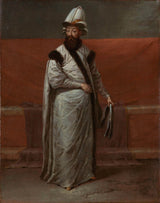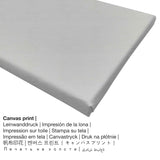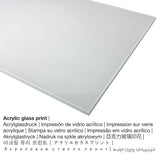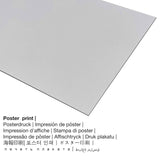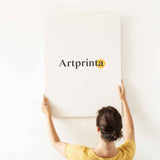Jean Baptiste Vanmour, 1727 - Grand Vizier Damat Ibrahim Pasa Nevşehirli - mbipụta nka mara mma.
Ụtụ gụnyere. Mbupu gbakọrọ na ndenye ọpụpụ.
Ozi ndabere na nka nka aha ya bụ "Grand Vizier Damat Ibrahim Pasa Nevşehirli"
In 1727 Jean Baptiste Vanmour created this artpiece. The work of art is included in the collection of Rijksmuseum. Site n'ikike nke - Rijksmuseum (ikike ngalaba ọha): . Ọzọkwa, nhazi nke mmepụta dijitalụ bụ Eserese n'akụkụ akụkụ nke 3: 4, nke pụtara na ogologo bụ 25% mkpụmkpụ karịa obosara.
Họrọ nhọrọ ihe
In the product dropdown lists you can choose the material and size of your choice. Hence, we allow you to choose among the following options:
- Mbipụta akwụkwọ mmado (akwa akwa akwa): The Artprinta poster print is a UV printed flat cotton canvas paper with a granular surface structure. It is particularly qualified for framing the art copy with a personal frame. Please bear in mind, that depending on the size of the poster print we add a white margin of something between 2 - 6cm round about the artwork in order to facilitate the framing with a custom frame.
- Mbipụta kanvas: The printed canvas, which shall not be confused with a real painting on a canvas, is a digital copy printed on an industrial printing machine. The advantage of canvas prints is that they are relatively low in weight, meaning that it is easy to hang the Canvas print without extra wall-mounts. Canvas prints are suitable for any kind of wall.
- Mbipụta iko acrylic na-egbuke egbuke (nke nwere ezigbo mkpuchi iko n'elu): An print on acrylic glass, which is often referenced as a fine art print on plexiglass, will turn your favorite artwork into wall decoration. Your work of art will be manufactured with the help of modern UV direct print machines. The plexiglass protects your chosen art print against light and external influences for between 40-60 years.
- Mbipụta aluminom (aluminium dibbond): An Aluminium Dibond print is a material with a true depth effect - for a modern look and a non-reflective surface. Colors are luminous, fine details appear crisp and clear.
Nkwupụta iwu: We do whatever we can to depict the art products as accurate as possible and to display them visually in our shop. At the same time, the colors of the print materials, as well as the print result may vary slightly from the presentation on your device's screen. Depending on the settings of your screen and the quality of the surface, not all colors can be printed one hundret percent realistically. Given that all fine art prints are printed and processed manually, there may also be slight differences in the motif's size and exact position.
Banyere ngwaahịa a
| Nkewa edemede: | mmepụta nka |
| Usoro mmeghari: | dijitalụ mmeputakwa |
| Usoro mmepụta: | Mbipụta UV ozugbo |
| Nlụpụta: | German mere |
| Ụdị ngwaahịa: | na mmepụta ihe |
| Eji ngwaahịa a chọrọ: | mkpokọta nka (mmeputakwa), mgbidi gallery |
| Ndepụta: | usoro eserese |
| Oke akụkụ onyonyo: | 3:4- (ogologo: obosara) |
| Nsonaazụ nke oke onyonyo: | ogologo bụ 25% mkpụmkpụ karịa obosara |
| Ụdị dị iche iche dị: | akwụkwọ mmado (akwụkwọ kwaaji), mbipụta ọla (aluminium dibond), mbipụta iko acrylic (nke nwere ezigbo mkpuchi iko), mbipụta akwụkwọ. |
| Nhọrọ nke akwa akwa n'elu etiti ihe ndọtị (mbipụta akwa akwa): | 30x40cm - 12x16", 60x80cm - 24x31", 90x120cm - 35x47", 120x160cm - 47x63" |
| Mpempe iko acrylic (nwere ezigbo mkpuchi iko) nha: | 30x40cm - 12x16", 60x80cm - 24x31", 90x120cm - 35x47", 120x160cm - 47x63" |
| Ụdị akwụkwọ mmado (akwụkwọ kwaaji) dị iche iche: | 30x40cm - 12x16", 60x80cm - 24x31", 90x120cm - 35x47" |
| Nhọrọ ebipụta aluminom: | 30x40cm - 12x16", 60x80cm - 24x31", 90x120cm - 35x47" |
| ụba: | agunyeghi |
Nkọwa ihe osise
| Aha eserese: | "Grand Vizier Damat Ibrahim Pasa Nevşehirli" |
| Nhazi nka nka: | sere |
| Otu sara mbara: | nka ochie |
| Narị afọ nka: | 18th narị afọ |
| Afọ nka: | 1727 |
| Ogologo afọ nka nka: | karịa afọ 290 |
| Egosiputara na: | Rijksmuseum |
| Ebe ebe ngosi nka: | Amsterdam, Netherlands |
| Weebụsaịtị ihe ngosi nka: | Rijksmuseum |
| License: | ngalaba ọha |
| Site n'aka: | Rijksmuseum |
Ozi ndabere gbasara onye na-ese ihe
| Ihe nkiri: | Jean Baptiste Vanmour |
| Aha ndị ọzọ: | Jan Baptista van Mour, Van Moor Jean-Baptiste, J.B. van Moor, Mour Jean Baptiste van, Van Moor Jean Baptiste, Jean-Baptiste van Mour, Jean Baptiste Vanmour, Van-Mour, Vanmour Jean Baptiste, Vanmour Jean-Baptiste, Mour Jean-Baptiste van, Moor Jean-Baptiste van, Jean Baptiste Van Mour, Mour, Vanmour, Van Mour Jean Baptiste, Van Mour Jean-Baptiste |
| okike onye nka: | nwoke |
| Obodo onye nka: | French |
| Ọrụ nke onye na-ese ihe: | onye na-ese ihe |
| Obodo onye nka: | France |
| nhazi ọkwa: | nna ukwu ochie |
| Ndụ: | 66 afọ |
| Afọ amụrụ: | 1671 |
| Ebe amụrụ onye: | Valenciennes, Hauts-de-France, France |
| Afọ nwụrụ: | 1737 |
| Nwụrụ na (ebe): | Istanbul, Istanbul, Turkey |
Nwebiisinka © - Artprinta.com (Artprinta)
Ozi mgbakwunye site na Rijksmuseum webụsaịtị (© Nwebiisinka - site Rijksmuseum - www.rijksmuseum.nl)
The sultan was the head of state, but the grand vizier was the most powerful man behind the scenes. Together with the Imperial Council, he was in charge of the daily running of the Ottoman Empire. Under the joint rule of Sultan Ahmed III and Grand Vizier Ĭbrahim Pasa, Turkish culture experienced a period of prosperity known as the Tulip Era.

